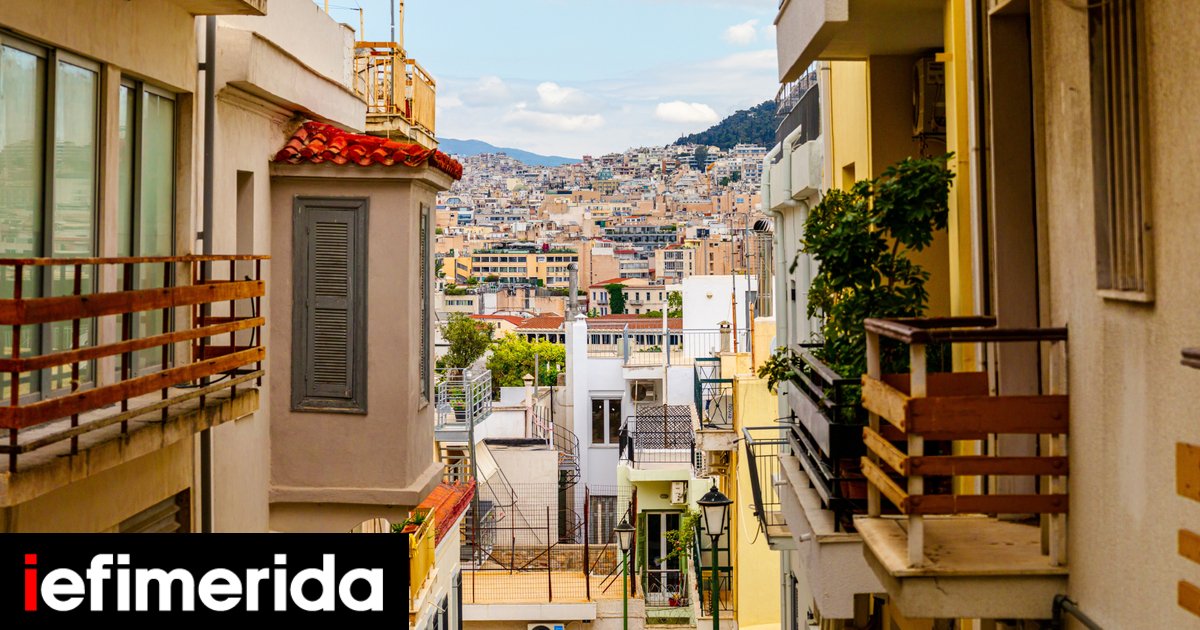
Detailed Guide with 10 + 1 Questions and Answers to the Program »my house – Youth housing policy and the use of public property for social housing, ”the Ministry of Labor announced.
Billing his ambitious Betty program, among others Low interest loans for young people, today in the plenary session of Parliament. This is the reform that kicks off the new housing policy announced by the Prime Minister at TIF.
“Save – Renew” for young people: these areas receive a 15% bonus – spending up to 35,000 € [οδηγός]
“Change My Device”: How to check out and buy a new device – 148 thousand new beneficiaries [οδηγός]
Betty: 10 + 1 “SOS” for the new housing policy program
The Ministry of Labor and Social Affairs provides answers to ten plus one questions regarding the bill on the government’s new housing policy.
1. What does the mortgage loan program offer and what is the benefit for the new couples who will join it?
In practice, those who join this program will pay a mortgage installment that will be much lower than the corresponding rent for their chosen home, as the interest rate will correspond to a quarter of commercial rates. And in any case, it will be zero for families with three and many children. Most importantly, by paying off the loan they will gain ownership of the home. In addition, the loan will cover a higher percentage of the commercial value of the property (90%) than bank mortgages which typically cover up to 80%. This means that the private contribution that young people have to contribute is reduced to 10% of the value of the house instead of the 20% stipulated in the bank mortgage contracts.
Also, with this program, families who under normal circumstances could barely meet the bank’s financing criteria can access bank loans.
2. What’s new in the Youth Mortgage Program?
A number of new elements have been added regarding the initial declarations aimed at speeding up the execution of the procedure, but also to protect against possible violations. specially:
– A €200,000 cap has been placed on the value of the home that beneficiaries can purchase. This precludes the possibility of purchasing luxury buildings through the loan subsidized program.
It is prohibited to purchase the property by a first-degree relative of the borrower.
– It becomes clear that there will be no guarantor for the loan.
– There is a grace period of 8 months (6 months initially, with the possibility of a 2-month extension) from pre-approval of the loan until the signing of the loan agreement. This prevents delays that would commit loan funds at the expense of other beneficiaries who have closed the property purchase agreement.
3. The Home Loan Grant Program provides for a maximum loan amount of €150,000. Do you consider this limit realistic? Are there homes at this price?
In dozens of urban center areas as well as in the periphery, there are properties available in this size class that can meet the housing needs of young people. Indicative: objective values in Agia Paraskevi range from 1,500 to 2,050 € per square meter, in Marousi 1,500-2,300 €, in Pefki 1,300 – 2,250 €, in the 4th municipal district of Thessaloniki (Tumba) 1,250-1,550 €. It should be noted that the objective values relate to newly built real estate, while the mortgage loan program relates to real estate built until 2007, whose value is obviously lower than that of newly built ones.
It is clear that there are properties that are much more expensive, but we must not forget that we are dealing with a social program to facilitate access to housing aimed at freeing young people from large costs, uncertainties and problems. The €150,000 cap, like the €200,000 cap for the property value, is the golden ratio between the limits set by the market and the need to join the program with as many beneficiaries as possible.
4. What is Coverage and who can join it?
The “coverage” program is based on vacant homes that will be released from the “Estia” program in which more than 1,000 private homes have been leased by the state and made available to immigrants for a transitional period. The Estia program ends on December 31st. Immediately thereafter, these houses (subject to the consent of the owners, of course) will be repaired if necessary at public expense and provided free of charge or at a very low rent to vulnerable young people from 25 to 39 years of age, beneficiaries of a guaranteed minimum income. Priority will be given to multi-child, three-child and single-parent families with objective criteria (scoring). The program will be implemented by the General Secretariat for Social Solidarity and Poverty Alleviation at the Ministry of Labor and Social Affairs.
5. How will the partnership between the state and technical companies work in “social compensation”?
The basic philosophy, as announced, is that public entities (DYPA and others) will contribute undeveloped and unused land on which technical companies undertake after the bid to build homes and shops based on specifications to be specified in the bid notice. The companies will be repaid through the exploitation of the real estate, but they will be obliged to make available a proportion of the housing with lower rents to the beneficiaries of the social compensation scheme. Also, the government entity will retain ownership of the real estate. The duration of the concession will be specified in the tender announcement, as it cannot be uniform for all areas and land values. The goal is to house beneficiaries in quality real estate, but also to ensure that the program will attract private sector interest.
6. The opposition accuses you of giving away public property to major contractors with social benefits. what do you answer
With the new “Social Compensation” institution, the state’s inactive estates became available, without loss of title to the land, in long-term concessions to individuals who were guaranteed by contractual obligations to build modern homes that would be available at cheap rents. This is the most prevalent social housing practice that secured 20%-25% of real estate for example. In Austria or the Netherlands they are provided at regulated low rents. Similar initiatives were taken in socialist Spain. Doesn’t he know who can criticize that easily?
With social compensation, the state contributes the property that it does not use and remains unused, and the individuals undertake, after tendering, to build houses at their own expense and according to the state’s specifications, with the obligation to allocate a percentage of it to the state. Beneficiaries with low rents. In this way, cheap housing is guaranteed for those who join the program, state property and especially DYPA are used, construction begins and the practice of “ghettoing” workers’ housing is abandoned. Ownership of real estate is retained by the state in all cases, and the fastest supply of social housing is ensured.
7. What is the “Rental Renewal” program and how is it different from “Save”?
The “Renovate-Rent” program provides subsidies to renovate closed homes in order to make them available for rent. In other words, it aims to increase the housing supply by providing incentives for empty properties to be used again, once they have been returned to a usable condition. The “Excoionamo” programmes, to which thousands of homes have joined, relate to properties that have already been used as a first home, dwelling or rented. It should be noted that through the “Renovation – Rent” programme, subsidies of up to 40% (maximum 10,000 euros) are provided for home renovations (works and materials), up to 100 square metres. In urban centers, in order to make it available for rent. The owner of the house must have a taxable family income of up to 40,000€ and an estate of up to 300,000€, and the house must be declared vacant on the E2 form. The program guide has been previously published.
8. Why is it necessary to add a new private urban planning use of social housing?
This ensures that public buildings that previously had a different use (for example, hotels, schools, etc.) public, etc.) is allowed.
9. What does the regulation provide for the abolition of the privileges of public property?
It has been shown that public bodies have endowed their property to fulfill a specific public purpose (for example, to house municipal services or to serve cultural purposes), but without, although a considerable period of time has passed, that purpose has been satisfied. The regulation being introduced states that all bodies of the general government shall be invited to examine the real estate liens they have made, and if 15 years have passed without their purpose having been fulfilled, to proceed to annul the lien. A period of 15 years is seen as more than sufficient in order to reach a conclusion as to whether there is a will and/or possibility to achieve the purpose. In addition, a two-month deadline was set within which the franchisor can document the need to continue the franchise if he deems it necessary. In any case, it is inconceivable that state property should remain bound and unused, while it could be used to house families.
10. What programs can landlords participate in?
Owners have multiple benefits. For example, owners who will participate in the Coverage program will receive a guaranteed income from the rent paid by the state for their homes, which will be allocated to new beneficiaries of the minimum guaranteed income. The state also undertakes reforms.
On the other hand, the program of collective use of closed private homes provides for their owners to give them for a period of at least 5 years to the state, which will undertake to restore them and make them available to young people and new couples.
With the ‘Renew – Rent’ programme, owners of closed homes will be supported to renovate them provided they are made available for a minimum 3 year lease.
Finally, the Save – Renovate program provides a range of subsidies and zero or low interest loans to young people to renovate and upgrade their homes.
11. Why is it necessary to pass a new housing policy bill? Is the current institutional framework insufficient?
It was already indicated during the program presentation that a number of new provisions would need to be passed to implement or accelerate the implementation of the government’s new housing strategy. After all, the state has been absent from the field of housing policy in recent years. New tools have been added, such as social compensation, that need to be added to DYPA’s “toolbox” in order to implement it quickly and transparently.
More videos

“Avid problem solver. Extreme social media junkie. Beer buff. Coffee guru. Internet geek. Travel ninja.”





More Stories
Which brands have not sold a single new car in Greece?
The unknown trick – for just 1 euro you can make your car's windshield look like new
Two groups lay down “secret” rocket fuel.